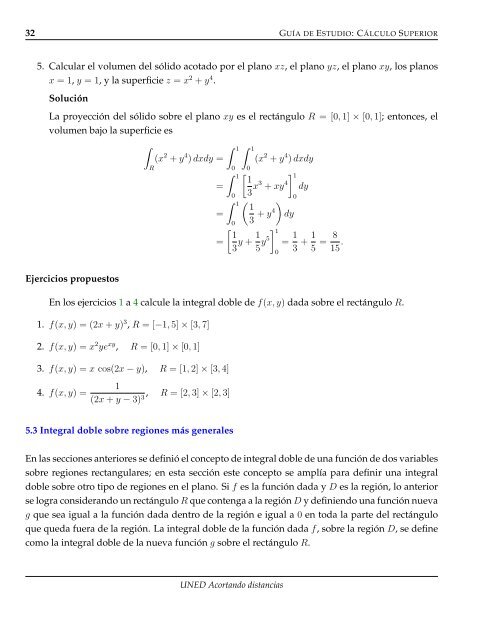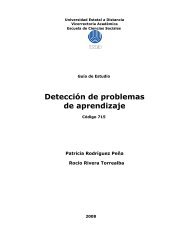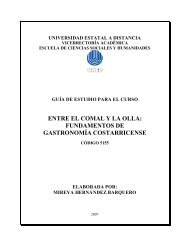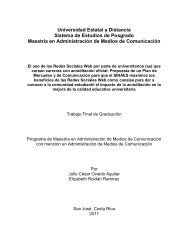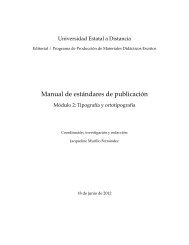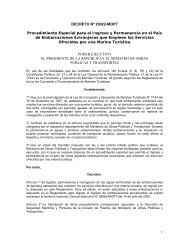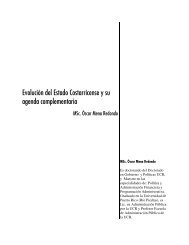GE3011 Cálculo Superior - Repositorio de la Universidad Estatal a ...
GE3011 Cálculo Superior - Repositorio de la Universidad Estatal a ...
GE3011 Cálculo Superior - Repositorio de la Universidad Estatal a ...
Create successful ePaper yourself
Turn your PDF publications into a flip-book with our unique Google optimized e-Paper software.
32 GUÍA DE ESTUDIO: CÁLCULO SUPERIOR<br />
5. Calcu<strong>la</strong>r el volumen <strong>de</strong>l sólido acotado por el p<strong>la</strong>no xz, el p<strong>la</strong>no yz, el p<strong>la</strong>no xy, los p<strong>la</strong>nos<br />
x = 1, y = 1, y <strong>la</strong> superficie z = x 2 + y 4 .<br />
Solución<br />
La proyección <strong>de</strong>l sólido sobre el p<strong>la</strong>no xy es el rectángulo R = [0, 1] × [0, 1]; entonces, el<br />
volumen bajo <strong>la</strong> superficie es<br />
Ejercicios propuestos<br />
<br />
R<br />
(x 2 + y 4 ) dxdy =<br />
=<br />
=<br />
=<br />
1 1<br />
0<br />
1<br />
0<br />
(x 2 + y 4 ) dxdy<br />
1 dy<br />
0<br />
<br />
1<br />
0 3 x3 + xy 4<br />
1 <br />
1<br />
+ y4 dy<br />
0 3<br />
<br />
1 1<br />
y +<br />
3 5 y5<br />
1 = 1 1<br />
+<br />
3 5<br />
0<br />
= 8<br />
15 .<br />
En los ejercicios 1 a 4 calcule <strong>la</strong> integral doble <strong>de</strong> f(x, y) dada sobre el rectángulo R.<br />
1. f(x, y) = (2x + y) 3 , R = [−1, 5] × [3, 7]<br />
2. f(x, y) = x 2 ye xy , R = [0, 1] × [0, 1]<br />
3. f(x, y) = x cos(2x − y), R = [1, 2] × [3, 4]<br />
4. f(x, y) =<br />
1<br />
, R = [2, 3] × [2, 3]<br />
(2x + y − 3) 3<br />
5.3 Integral doble sobre regiones más generales<br />
En <strong>la</strong>s secciones anteriores se <strong>de</strong>finió el concepto <strong>de</strong> integral doble <strong>de</strong> una función <strong>de</strong> dos variables<br />
sobre regiones rectangu<strong>la</strong>res; en esta sección este concepto se amplía para <strong>de</strong>finir una integral<br />
doble sobre otro tipo <strong>de</strong> regiones en el p<strong>la</strong>no. Si f es <strong>la</strong> función dada y D es <strong>la</strong> región, lo anterior<br />
se logra consi<strong>de</strong>rando un rectángulo R que contenga a <strong>la</strong> región D y <strong>de</strong>finiendo una función nueva<br />
g que sea igual a <strong>la</strong> función dada <strong>de</strong>ntro <strong>de</strong> <strong>la</strong> región e igual a 0 en toda <strong>la</strong> parte <strong>de</strong>l rectángulo<br />
que queda fuera <strong>de</strong> <strong>la</strong> región. La integral doble <strong>de</strong> <strong>la</strong> función dada f, sobre <strong>la</strong> región D, se <strong>de</strong>fine<br />
como <strong>la</strong> integral doble <strong>de</strong> <strong>la</strong> nueva función g sobre el rectángulo R.<br />
UNED Acortando distancias


